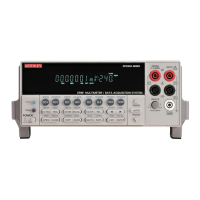Calibration Reference B-23
Error queue
As with other Model 2700 errors, any calibration error will be reported in the bus error
queue. You can read this queue by using the :SYST:ERR? query. The Model 2700 will respond
with the appropriate error message, as summarized in Table B-5.
Status byte EAV (Error Available) bit
Whenever an error is available in the error queue, the EAV (Error Available) bit (bit 2) of the
status byte will be set. Use the *STB? query or serial polling to obtain the status byte, then test
bit 2 to see if it is set. If the EAV bit is set, an error has occurred, and you can use the
:SYST:ERR? query to read the error and at the same time clear the EAV bit in the status byte.
Generating an SRQ on error
To program the instrument to generate an IEEE-488 bus SRQ when an error occurs, send the
following command: *SRE 4. This command will enable SRQ when the EAV bit is set. You can
then read the status byte and error queue as outlined above to check for errors, and to determine
the exact nature of the error.
Detecting calibration step completion
When sending remote calibration commands, you must wait until the instrument completes
the current operation before sending a command. You can use either *OPC? or *OPC to help
determine when each calibration step is completed.
Using the *OPC? query
With the *OPC? (operation complete) query, the instrument will place an ASCII 1 in the out-
put queue when it has completed each step. To determine when the OPC response is ready, do
the following:
1. Repeatedly test the MAV (Message Available) bit (bit 4) in the status byte and, wait
until it is set. (You can request the status byte by using the *STB? query or by serial
polling.)
2. When MAV is set, a message is available in the output queue, and you can read the out-
put queue and test for an ASCII 1.
3. After reading the output queue, repeatedly test MAV again until it clears. At this point,
the calibration step is completed.

